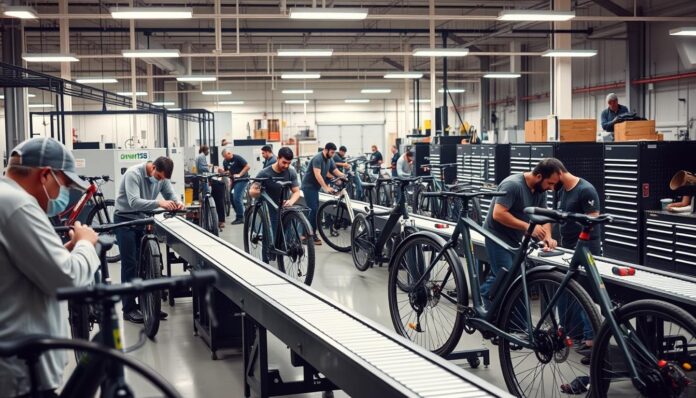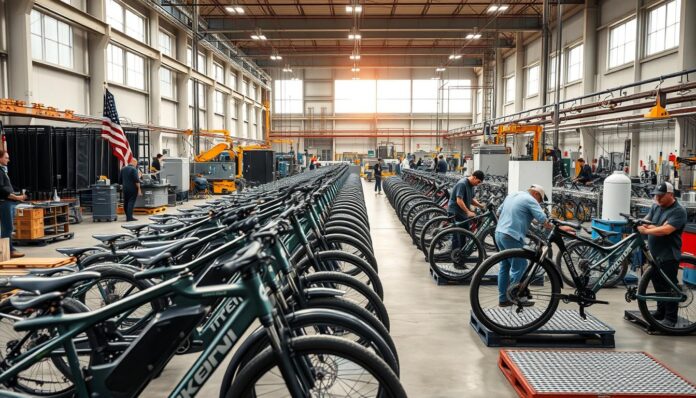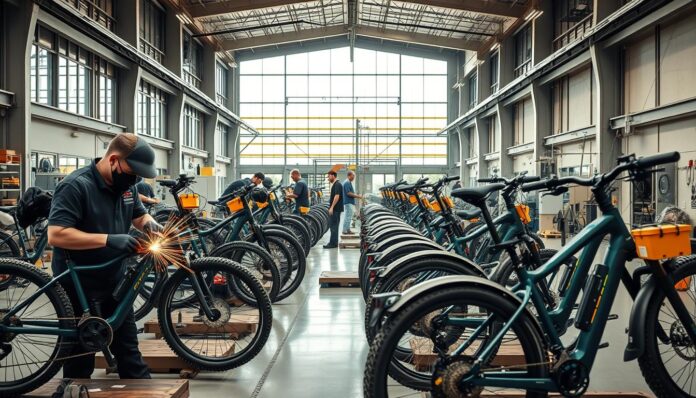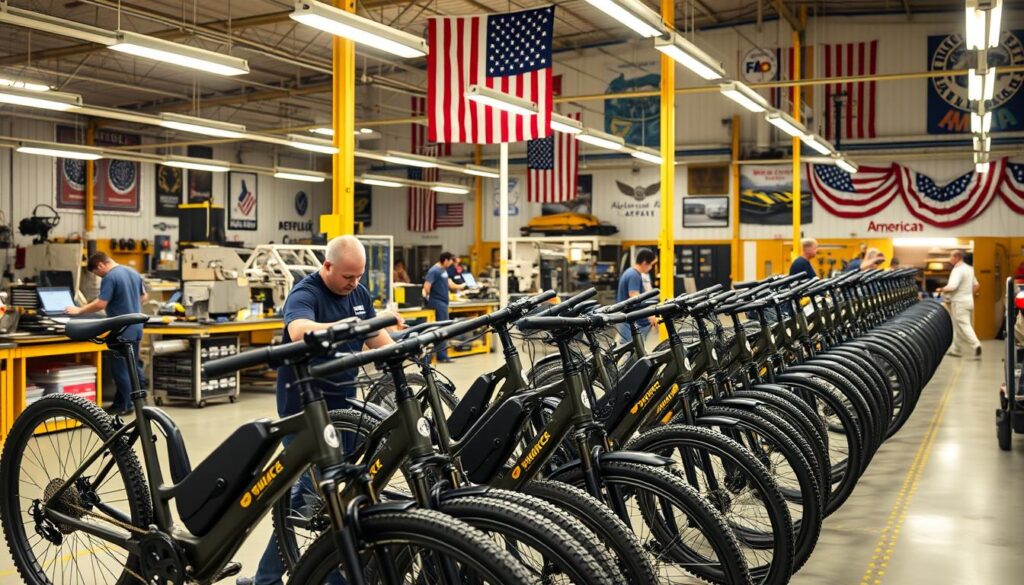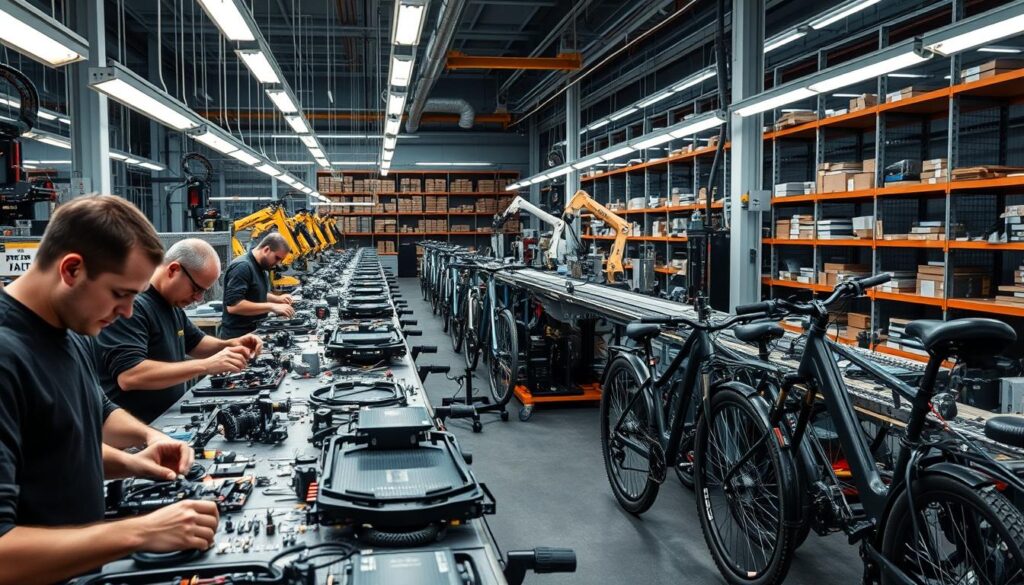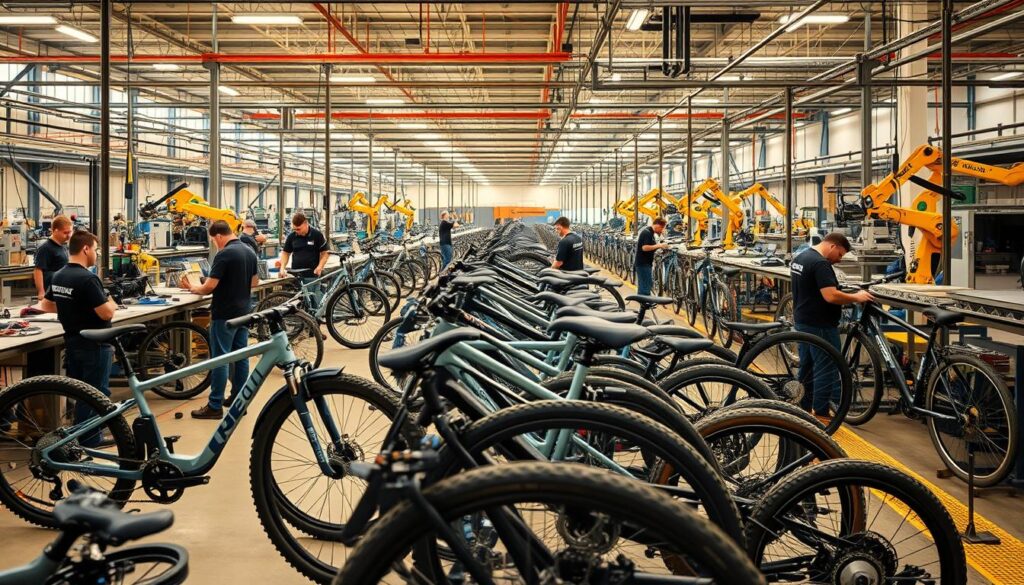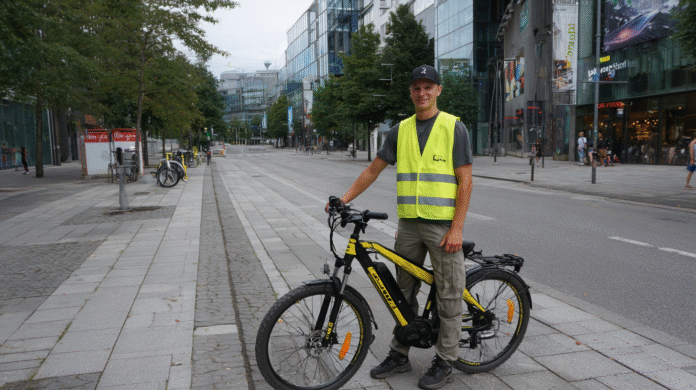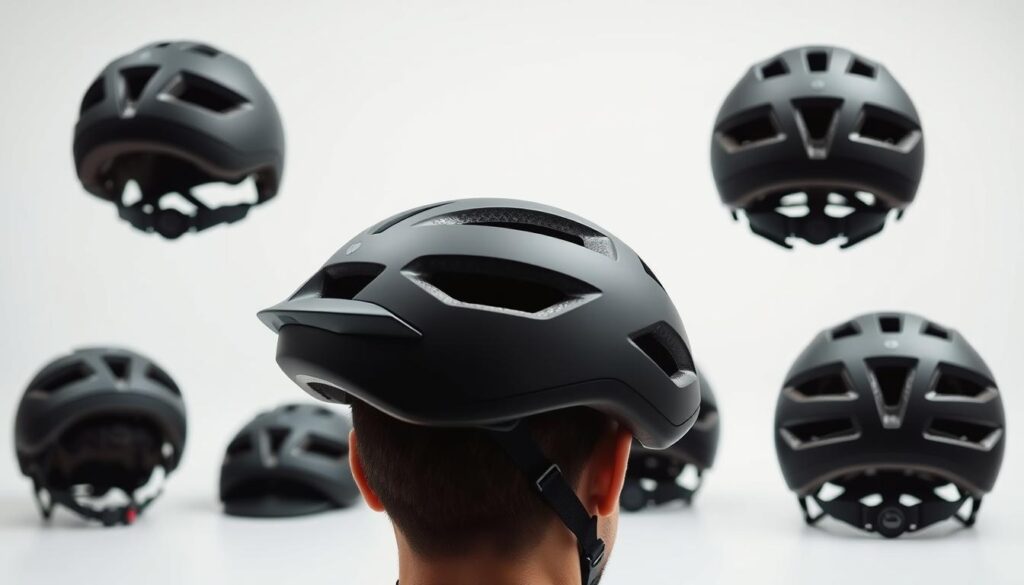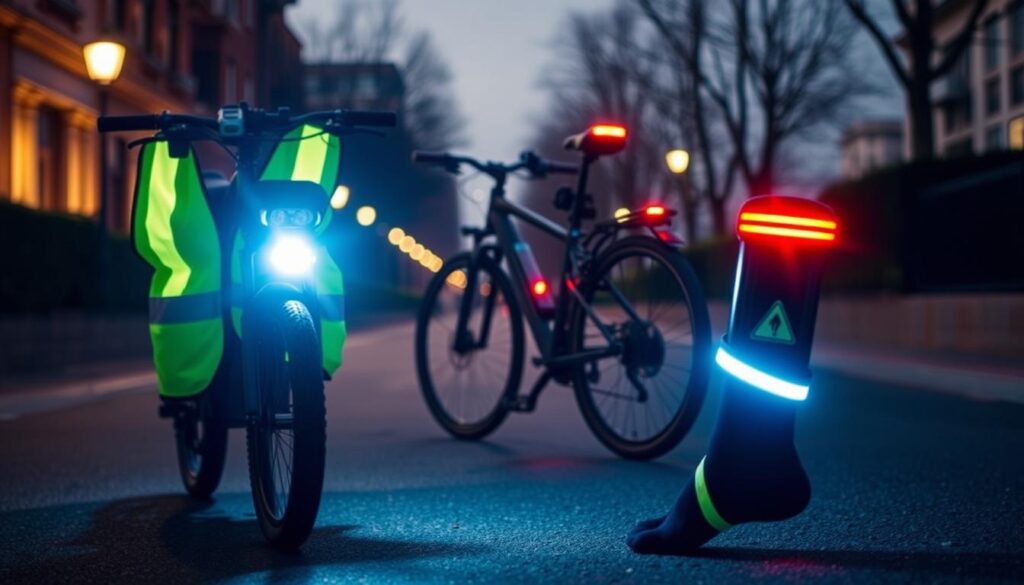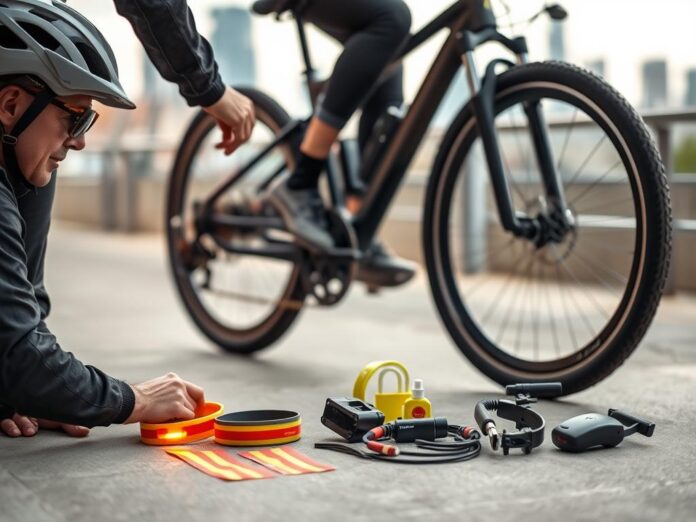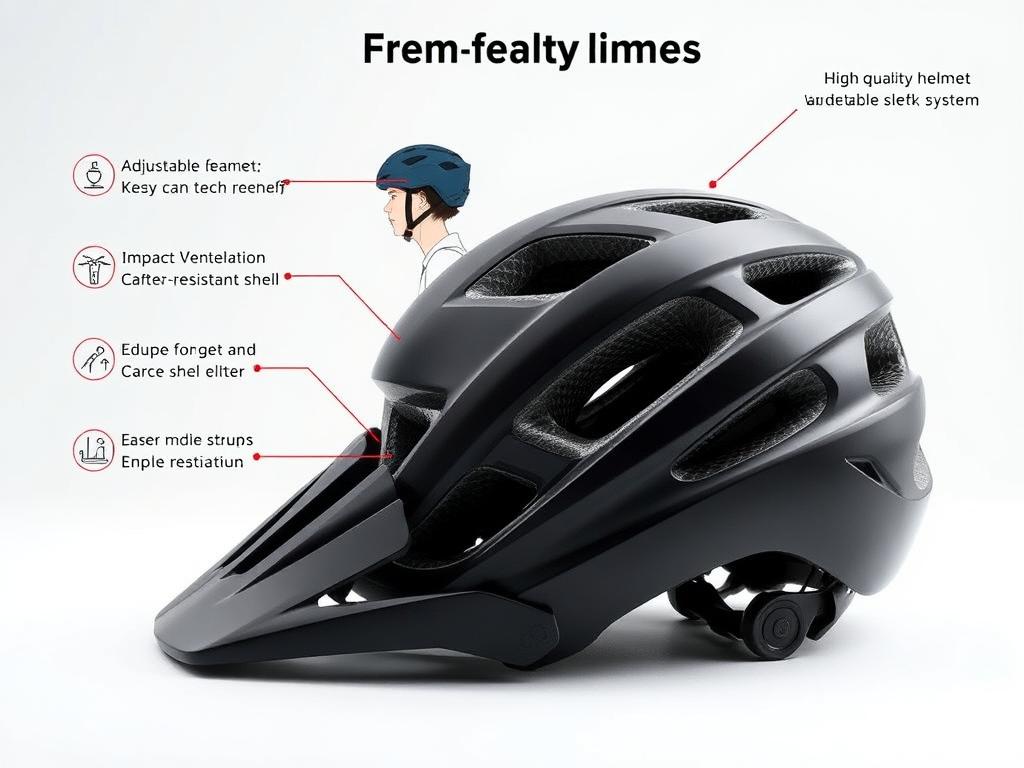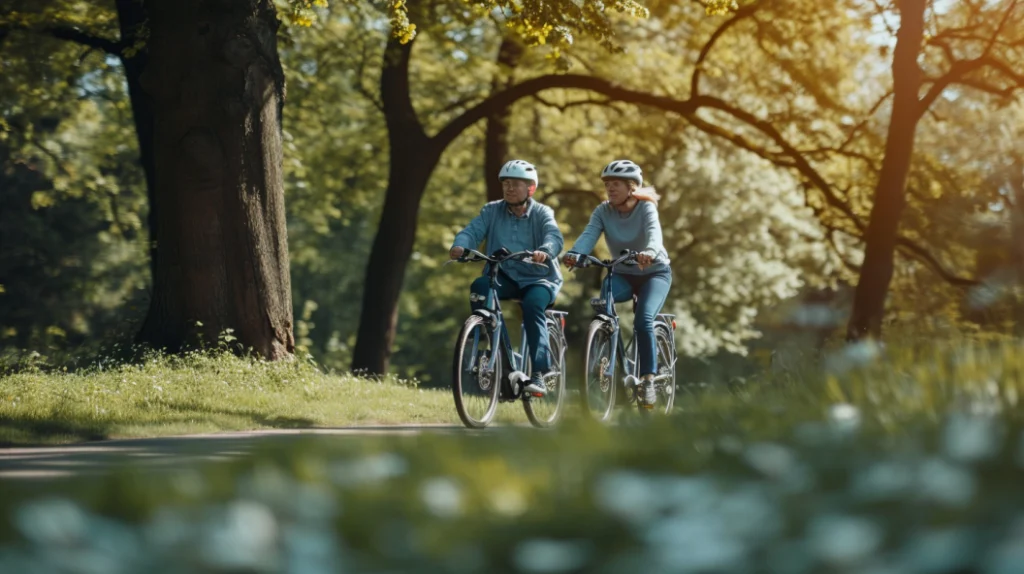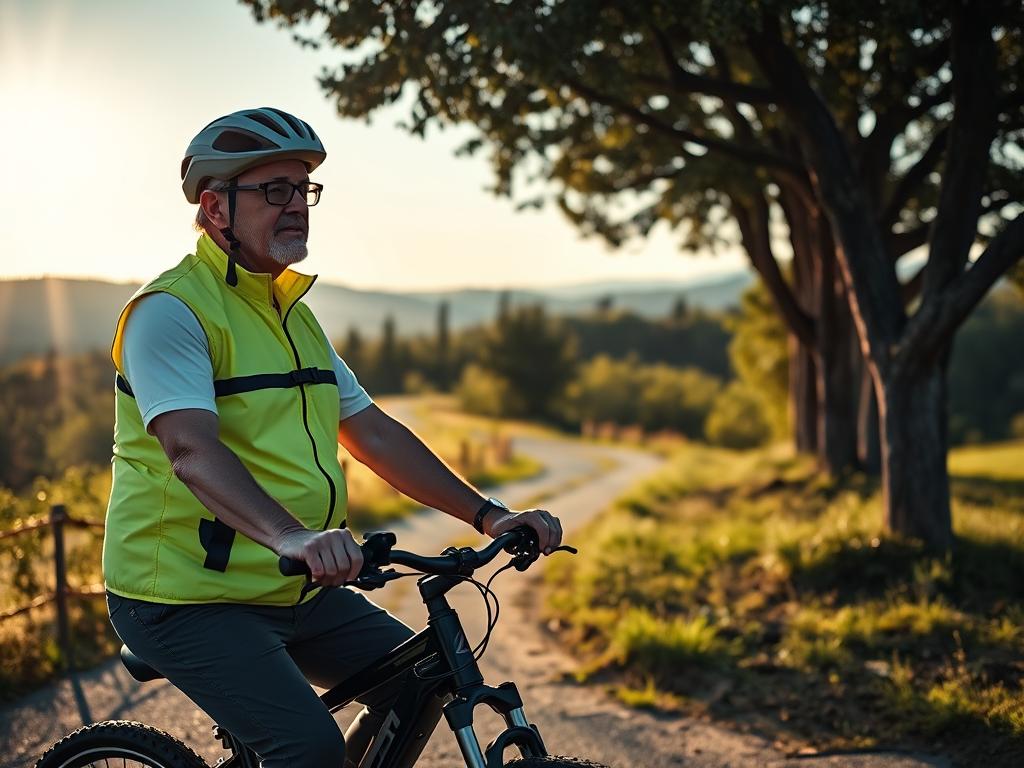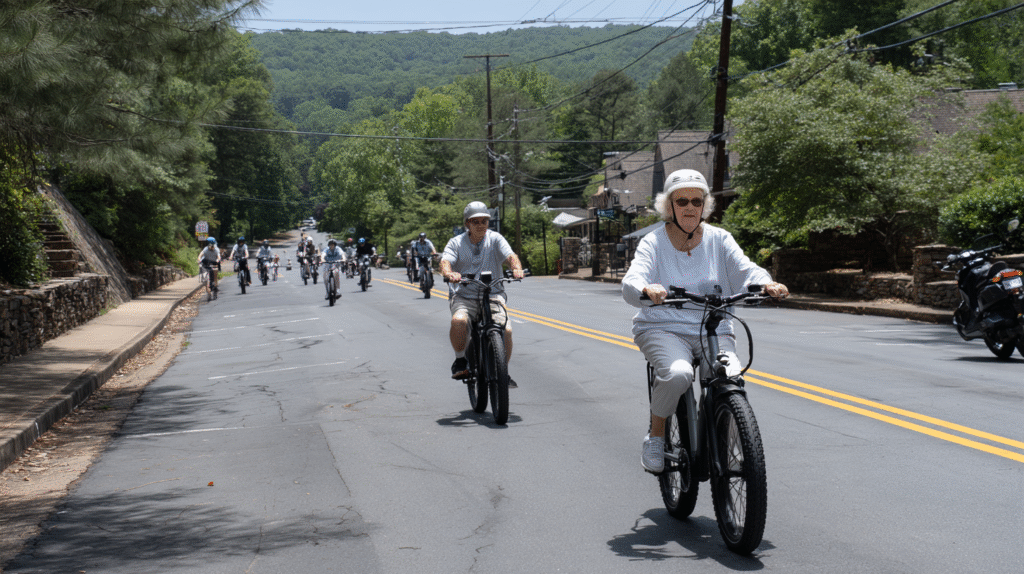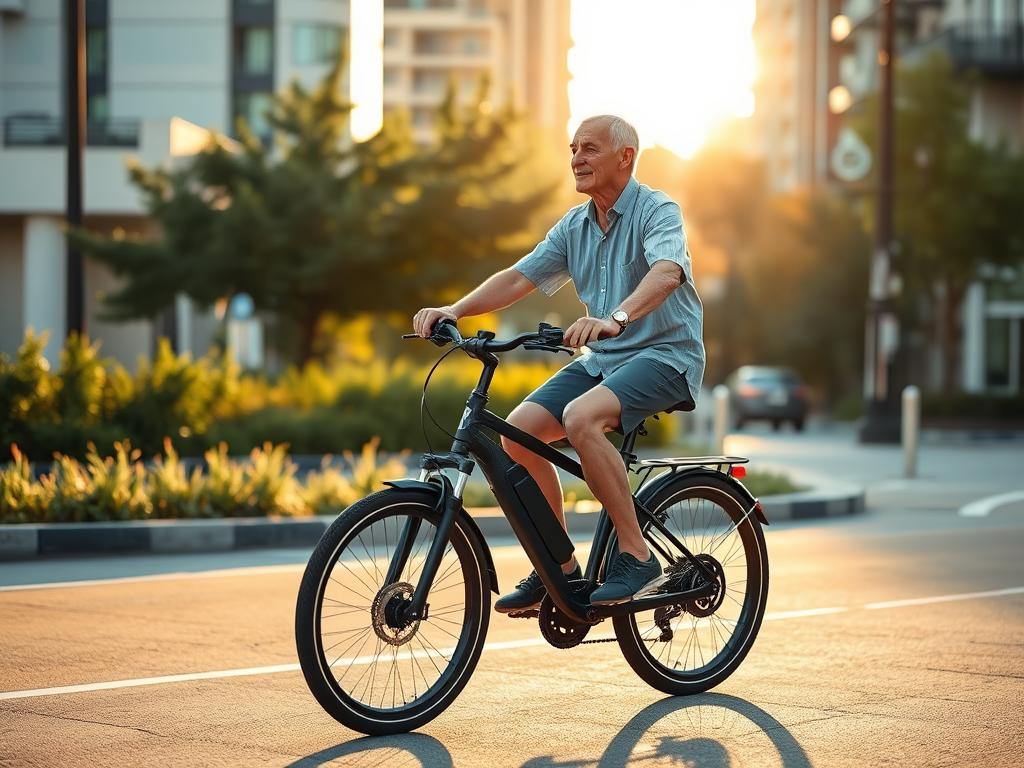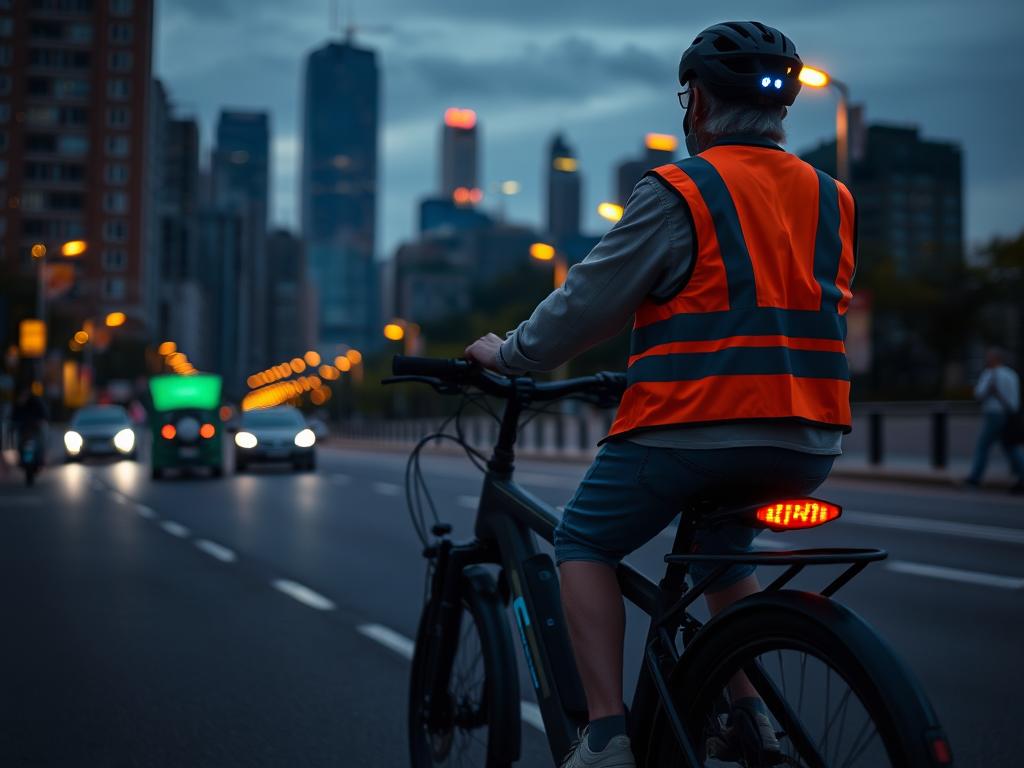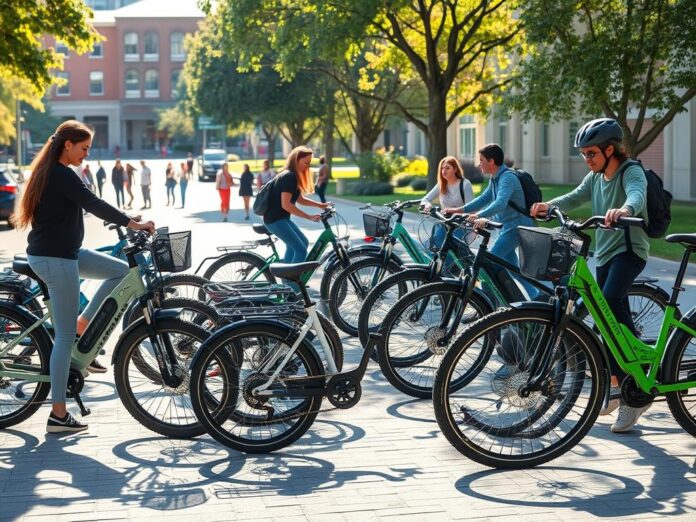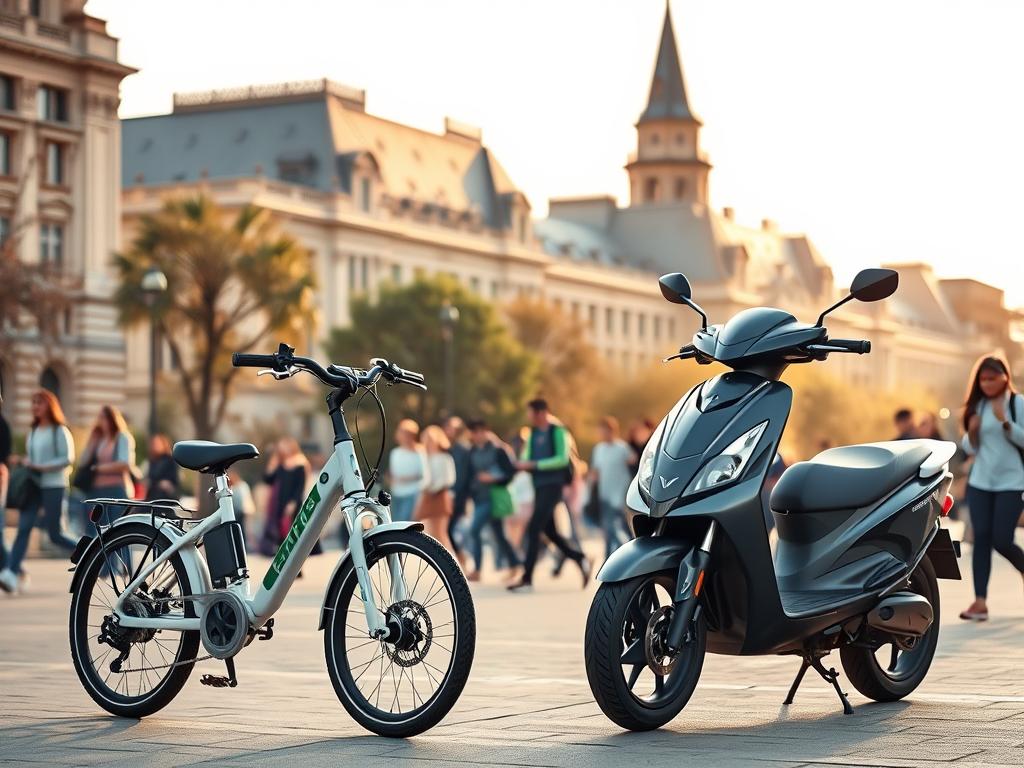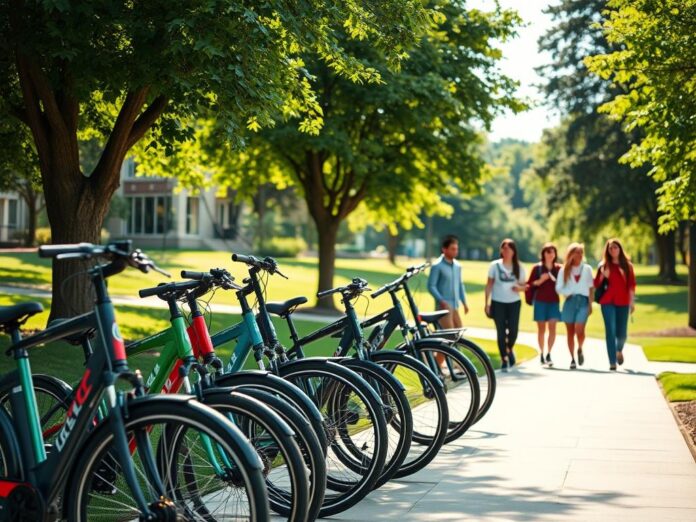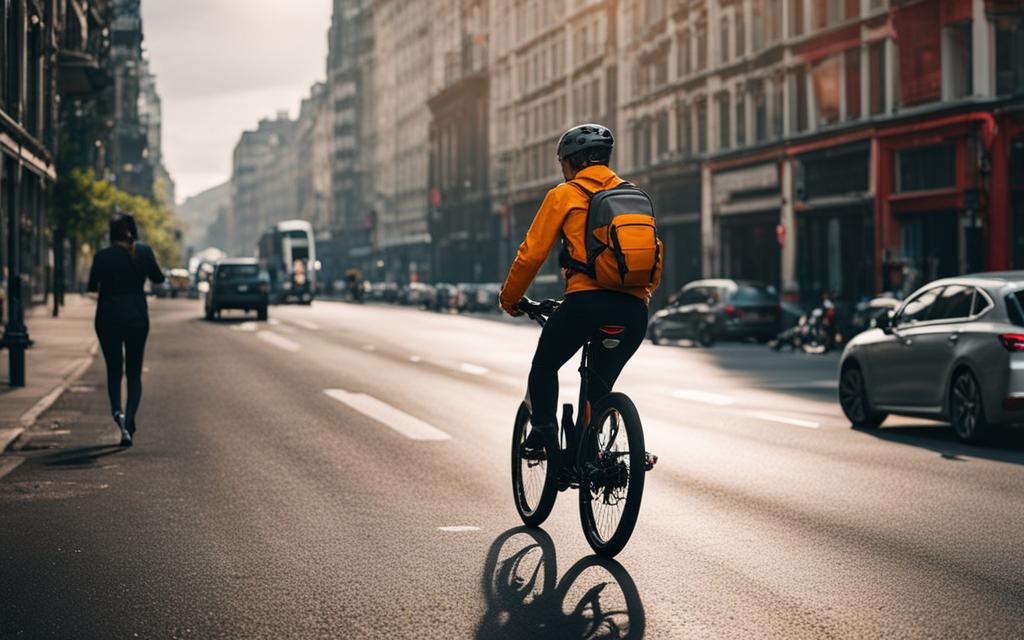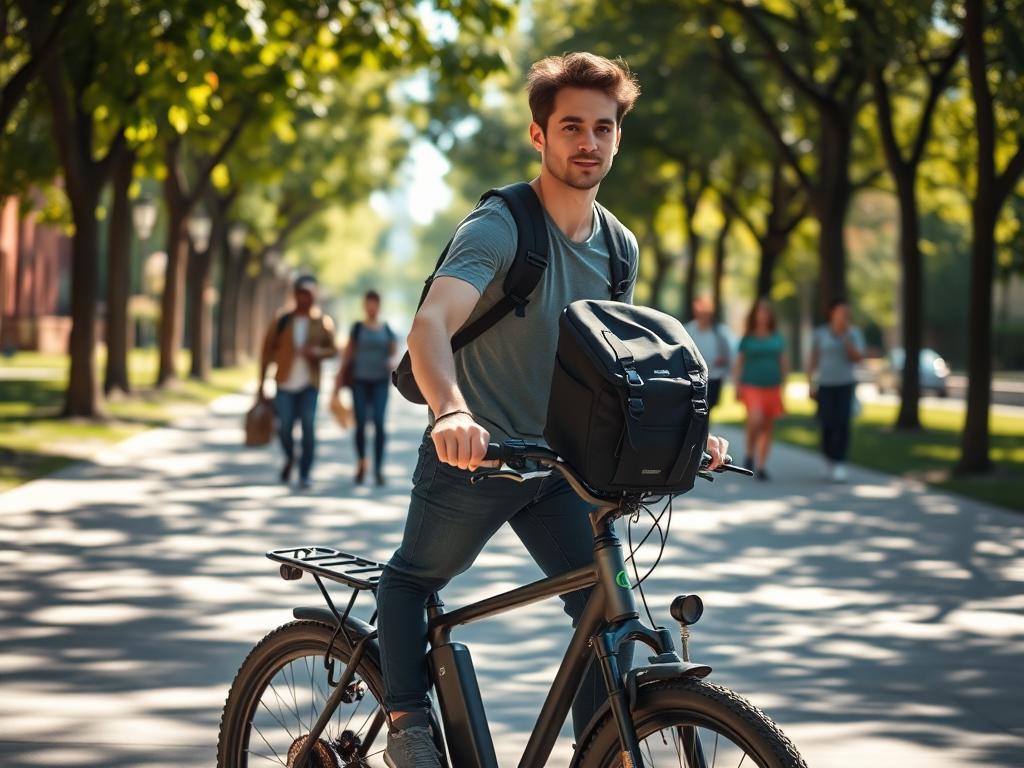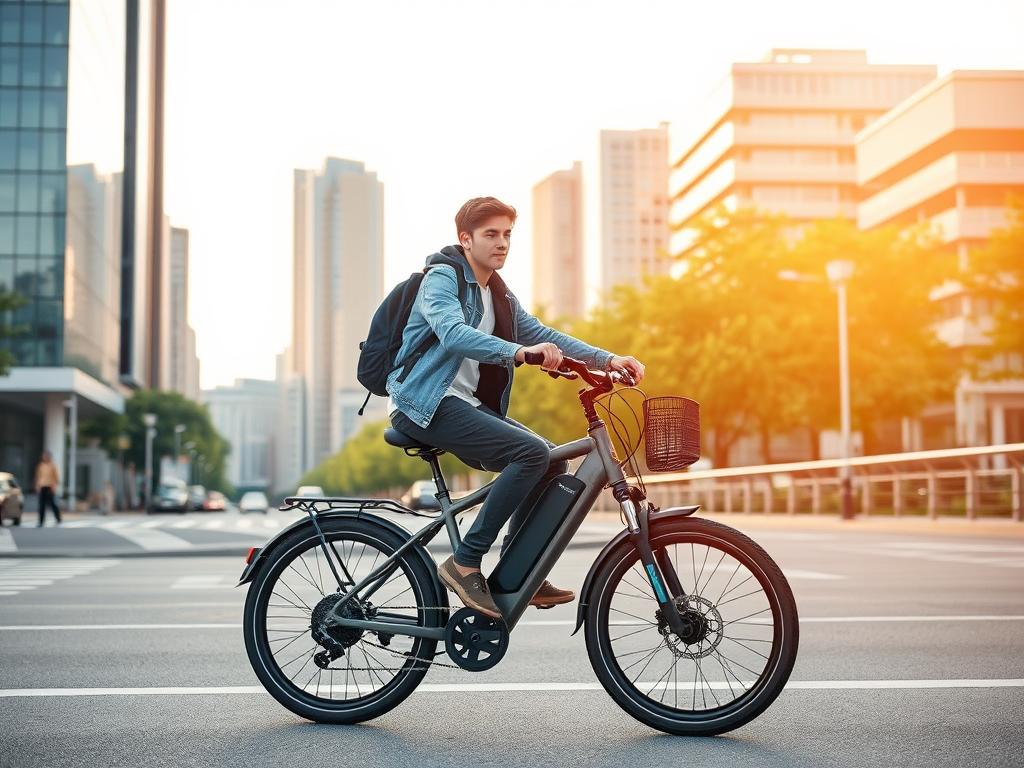Did you know less than 5% of electric bikes sold in America are made here? Yet, the demand for american-made e-bikes has grown by over 70% in two years. At EbikesUS.com, we’ve seen this trend ourselves, here is our take on Why You Should Be Buying USA Made Electric Bikes.
Domestic e-bike production is more complex than many think. Many brands say they’re American, but they often assemble bikes here after making parts elsewhere. The global supply chain makes locally produced e-bikes a rare find today.
But, some manufacturers are breaking this mold. Companies like Electric Bike Company in Newport Beach, California, and HPC, Detroit Bikes, are leading the way. They focus on high-quality craftsmanship and quality construction right here in America. They do everything from frame welding to wheel building here.
By choosing domestic manufacturing, riders do more than just get a bike. They support sustainable practices, create jobs, and get better products with warranties and service. It’s not just where the bike comes from—it’s the values and quality in every part.
Table of Contents for Why You Should Be Buying USA Made Electric Bikes
Key Takeaways
- Less than 5% of e-bikes sold in America are manufactured domestically
- Many “American” brands only perform final assembly in the US
- Companies like Electric Bike Company and Detroit Bikes lead in true US manufacturing
- American-made e-bikes typically offer superior warranties and customer service
- Buying domestic supports local jobs and often results in higher quality products
- US manufacturers focus on sustainable production practices
- The definition of “American-made” varies widely across the industry
Does an e-bike being ‘American-made’ mean it’s better quality?
Choosing an American-made e-bike is more than just supporting the USA. It’s about quality, craftsmanship, and value. Electric bikes are becoming popular for their eco-friendly nature. Consumers are now weighing the benefits of buying domestic against cheaper imports.
Understanding what “American-made” means can help you decide if the higher price is worth it. Does it really mean the bike is of better quality?
What is the difference between “Made in the USA” and “Assembled in the USA”?
When looking for electric bikes, the terms used are very important. These phrases show different manufacturing methods, affecting quality and cost.
“Made in the USA” means all parts and processing happen here. This includes frame welding, wheel building, and painting. Companies like Detroit Bikes and Electric Bike Company do this in their American workshops.
“Assembled in the USA” means only the final steps happen here. Frames and major parts come from overseas, often Asia. This requires less equipment and labor than making everything here.
Look beyond marketing language when checking American-made claims. Look for specific terms like “welded in USA” or “frames built in USA.”
| Aspect | “Made in the USA” | “Assembled in the USA” | Impact on Quality |
|---|---|---|---|
| Frame Production | Welded domestically | Imported pre-made | Domestic welding often has stricter quality control |
| Component Sourcing | Mostly domestic with some imports | Primarily imported | Varies by specific component manufacturer |
| Quality Control | Throughout entire process | Primarily during final assembly | More inspection points typically mean fewer defects |
| Labor Standards | US labor regulations | Mixed (overseas + US) | Better working conditions often correlate with higher craftsmanship |
| Price Impact | Significantly higher | Moderately higher | Price premium funds quality control and craftsmanship |
How does US-based assembly improve quality control?
US-based e-bike manufacturing offers better quality control. American facilities follow stricter rules and safety standards than many overseas places.
For electric bikes, this is key because battery and motor quality affect performance and safety. US makers must meet UL safety standards, reducing risks like fires.
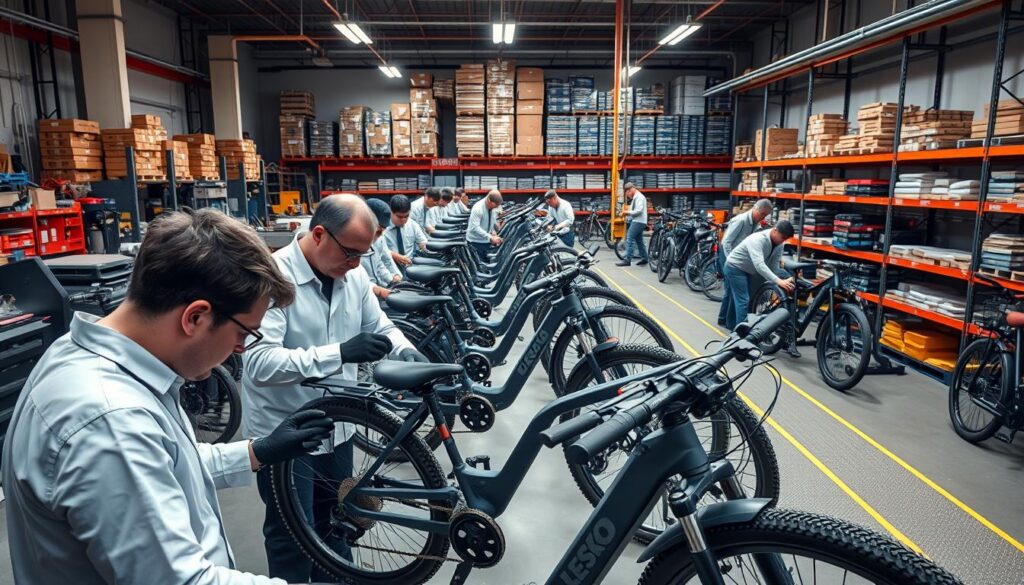
Production in the US means more inspections and quicker problem-solving. This leads to fewer defects and more reliable bikes.
The difference in quality control isn’t just about where the bike is made, but about the accountability and standards that location represents. When we build in America, we’re putting our reputation on the line with every weld and connection.
US assembly also means better working conditions and fair labor. This supports ethical manufacturing. While it may cost more, the quality and reliability are worth it.
Are components on American-made e-bikes also from the USA?
Today’s e-bike industry is complex. No bike is 100% American-made. Even US manufacturers import some parts for quality and cost reasons.
Important parts like motors come from Europe or Asia. Bosch (Germany), Shimano (Japan), and Bafang (China) lead the market. Battery cells also come from major international makers, though some US companies build packs using these cells.
Drivetrain parts like derailleurs and chains mostly come from Shimano or SRAM. Even American-focused makers import some parts for better quality and value.
The best American-made e-bikes have frames and wheels made here, with strategic imports for specialized parts. This mix offers quality, performance, and value for eco-friendly transport.
The role of craftsmanship and skilled labor in domestic e-bike manufacturing
American e-bike making preserves skills that might disappear. Frame welding, wheel building, and custom work need years of experience. These are skilled trades, not just assembly-line jobs.
Wheel building is a mix of art and science. It needs precise spoke tensioning and truing for durability and performance. Human expertise and attention to detail are key.
Welding a bicycle frame requires knowledge of metallurgy and fabrication. American makers use craftspeople with decades of experience. They take pride in their work.
This human touch means bikes with better detail, quality control, and innovative solutions. Many American makers offer custom options that mass production can’t match. Companies like Electric Bike Company provide personalized bikes.
These bikes have unique character and performance benefits. While they cost more, many riders find it worth it for the quality and durability. Skilled American labor makes a difference.
Buying American-made e-bikes supports local jobs and preserves manufacturing skills. It’s a quality choice and a patriotic one, supporting sustainability and community.
What does the future look like for making e-bikes in America?
The future of e-bike production in America looks bright. New players are entering the market, and big companies are growing. This growth is part of a bigger effort to boost American manufacturing and meet the demand for sustainable transportation.
Consumer interest in local products, government support, and new technology are creating great opportunities. Companies that focus on quality, innovation, and good prices will do well in this growing industry.
How is the growing e-bike market creating opportunities for US manufacturing?
The e-bike market is growing fast, creating new chances for American manufacturing. E-bikes are becoming more popular, from daily commutes to mountain biking.
Legislation like the Domestic Bicycle Production Act aims to help. It offers loans and incentives for making e-bikes in the US. This could make American-made e-bikes more competitive.
More people want to buy locally produced e-bikes. They’re willing to pay more for products that are good for the environment and support local jobs. This is true in the e-bike market, where people often choose eco-friendly options.
As more e-bikes are made in the US, prices might drop. This could help American manufacturers sell more e-bikes, not just the high-end ones.
Will building a domestic parts supply chain ever be possible?
Creating a US-based supply chain for e-bike parts is a big challenge. But it’s also a big opportunity. Most parts, like motors and batteries, are made overseas because of cost and expertise.
But things are changing. Government incentives and state programs are making it more attractive to make parts in the US. This could help create a stronger domestic supply chain.
The pandemic showed us how important it is to have parts made locally. Battery production, in particular, is getting more investment in the US. This is good for e-bikes and other electric vehicles.
Companies like Electric Bike Company are already making battery packs in the US. But they’re using imported cells. As battery production grows in the US, e-bikes will have better access to these parts.
A mix of making some parts in the US and importing others might be the way forward. This approach balances quality, cost, and supply chain strength.
The rise of boutique and custom e-bike builders in the United States
Boutique and custom e-bike builders are growing in the US. They offer unique designs, high-quality craftsmanship, and a personal touch that big companies can’t match.
These builders focus on different types of e-bikes, like high-performance mountain bikes or cargo bikes. They can innovate quickly, leading the industry.
Many of these builders let customers customize their e-bikes. This means everything from the frame to the paint can be tailored to the buyer’s liking. This personalization creates e-bikes that meet individual needs.
These builders sell directly to customers, cutting out the middleman. This means better prices and direct support from the makers. They offer advice on maintenance and use.
Boutique e-bikes are often more expensive but offer great value. They last long, perform well, and provide a unique experience. As the e-bike market grows, so will the demand for these custom bikes.
Are government incentives or tax credits for US-made e-bikes on the horizon?
Government support for e-bike manufacturing is growing. The proposed Domestic Bicycle Production Act offers tax credits for e-bikes made in the US. This could make American-made e-bikes more appealing.
This law recognizes the environmental benefits of e-bikes and their role in boosting American manufacturing. Buying an American-made e-bike could soon come with financial benefits.
States like Minnesota and California already offer rebates for e-bike purchases. These programs help make e-bikes more affordable and stimulate demand. This benefits domestic manufacturers.
These rebates can be up to $1,500, depending on income and bike type. Cities like Denver have similar programs, showing the trend toward supporting e-bikes.
These programs help domestic manufacturers by growing the market. They make premium, locally-made e-bikes more appealing. E-bikes are becoming a key part of federal transportation plans, which will help the industry grow.
As we focus more on climate goals, support for e-bikes will likely increase. This will help support domestic manufacturing and reduce our carbon footprint through more e-bike use.
How do world events and government rules change things for American e-bike companies?
The world of American e-bike makers is always changing. This is due to global events and new rules. These changes bring both hurdles and chances for making e-bikes in the US.
Tariffs Create Competitive Advantages
The 25% tariffs on Chinese e-bikes have made American ones more competitive. Many companies are now making their e-bikes in the US. This move creates jobs and keeps quality high.
At EbikesUS, we’ve noticed how these tariffs help American brands. They can now compete based on quality, not just price.
Pandemic Supply Chain Lessons
COVID-19 showed us how fragile global supply chains are. When e-bike demand went up and factories closed, it was tough. But, companies that made e-bikes in the US did better.
They had shorter, stronger supply chains. This taught us the importance of making parts locally. It also showed the dangers of relying too much on far-off factories.
Leading the Way in Battery Safety
Battery safety is now a big deal, with UL certification being key. American makers are leading in this area. They make battery packs in the US, following strict safety rules.
This focus on safety is both right and smart. It shows they care about quality and are ahead of the game.
Navigating Trade Agreements
Trade agreements make things tricky for e-bike parts sourcing. The USMCA has opened doors for North American making. Deals with Taiwan and South Korea help get special parts.
Choosing American-made e-bikes supports green transport. It also means you get reliable service and durable products.
FAQ
Q: What does “American-made” really mean for electric bikes?
A: “American-made” in e-bikes means key steps like welding and painting happen in the US. But, no e-bike is fully made here because of global parts. Companies like Electric Bike Company and Detroit Bikes do a lot of work in the US but also get parts from abroad.
Q: What is the difference between “Made in the USA” and “Assembled in the USA”?
A: “Made in the USA” means all important steps are done here, like welding and painting. “Assembled in the USA” means parts from overseas are put together here. Look for “welded in USA” or “frames built in USA” for true American-made products.
Q: How does US-based assembly improve quality control?
A: US production follows stricter rules and safety standards than many other places. This is key for e-bikes, where battery and motor quality matter a lot. American makers follow UL safety rules closely, making products safer and more reliable.
Q: Are components on American-made e-bikes also from the USA?
A: No e-bike is 100% made in the USA. Even US makers get some parts from abroad because of quality and cost. Motors and battery cells often come from places like Germany and Japan. But, American-made e-bikes have frames and wheels made here, with some parts from overseas.
Q: What role do craftsmanship and skilled labor play in domestic e-bike manufacturing?
A: US e-bike making keeps skills like welding and wheel building alive. These skills need years of practice. American makers focus on quality and customization, making each bike special.
Q: How is the growing e-bike market creating opportunities for US manufacturing?
A: The e-bike market’s growth means more jobs for US makers. Laws like the Domestic Bicycle Production Act help by lowering import costs. People also want to buy products that support local jobs and the environment.
Q: Will building a domestic parts supply chain ever be possible?
A: Creating a US parts supply chain is tough but possible. Government help and investment in battery tech are pushing for more US production. A mix of domestic and imported parts could work well, balancing quality and cost.
Q: What’s driving the rise of boutique and custom e-bike builders in the United States?
A: Boutique makers offer unique bikes and personal service that big companies can’t match. They innovate quickly and customize bikes for each customer. Their direct sales model means better service and value for customers.
Q: Are government incentives or tax credits for US-made e-bikes on the horizon?
A: Yes, the government is getting more involved. The Domestic Bicycle Production Act could give tax breaks for US-made e-bikes. States like Minnesota and California already offer rebates for buying e-bikes, helping make them more affordable.
Q: How do tariffs on Chinese e-bikes make US manufacturing more competitive?
A: Tariffs on Chinese e-bikes have changed the game. They make US production more attractive, even for mid-to-high-end bikes. Companies are moving production to the US to avoid these tariffs and create jobs.
Q: Why did the pandemic highlight the weaknesses of a global supply chain?
A: The pandemic showed how fragile global supply chains are. Shipping delays and part shortages were huge problems. But, US makers with local production were better off, showing the value of domestic production.
Q: How important are UL safety standards for e-bike batteries?
A: Battery safety is a big deal after some fires. UL certification is key, and US makers often go beyond the minimum. Cities like New York are making UL batteries a must, helping American makers stay ahead in safety.
Q: How do international trade agreements affect where e-bike parts are sourced from?
A: Trade deals with countries like Taiwan and Mexico make parts from there cheaper. But, USMCA is opening up North America for production. Makers need to balance cost, quality, and rules, making strategic choices.
Q: What are the environmental benefits of buying American-made e-bikes?
A: Buying American-made e-bikes cuts down on shipping pollution. US makers follow stricter environmental rules, making production cleaner. Plus, recycling and eco-friendly materials add to the green benefits.
Q: Are American-made e-bikes worth the higher price tag?
A: Yes, American-made e-bikes are worth the extra cost. They last longer, have better support, and support local jobs. The upfront cost is worth it for the long-term savings and the benefits to the US economy.


